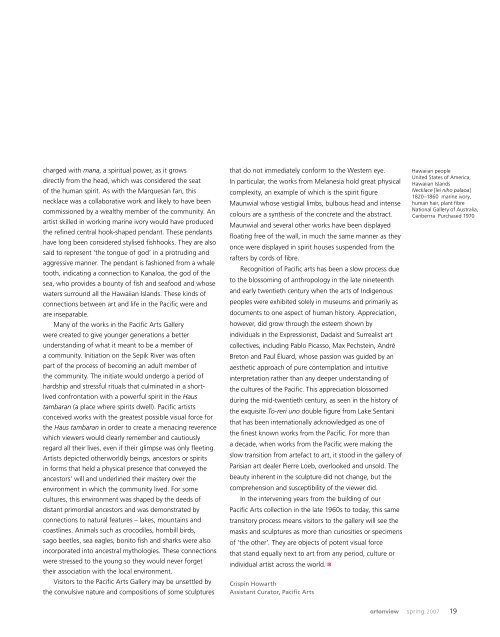Art Ew - National Gallery of Australia
Art Ew - National Gallery of Australia
Art Ew - National Gallery of Australia
Create successful ePaper yourself
Turn your PDF publications into a flip-book with our unique Google optimized e-Paper software.
charged with mana, a spiritual power, as it grows<br />
directly from the head, which was considered the seat<br />
<strong>of</strong> the human spirit. As with the Marquesan fan, this<br />
necklace was a collaborative work and likely to have been<br />
commissioned by a wealthy member <strong>of</strong> the community. An<br />
artist skilled in working marine ivory would have produced<br />
the refined central hook-shaped pendant. These pendants<br />
have long been considered stylised fishhooks. They are also<br />
said to represent ‘the tongue <strong>of</strong> god’ in a protruding and<br />
aggressive manner. The pendant is fashioned from a whale<br />
tooth, indicating a connection to Kanaloa, the god <strong>of</strong> the<br />
sea, who provides a bounty <strong>of</strong> fish and seafood and whose<br />
waters surround all the Hawaiian Islands. These kinds <strong>of</strong><br />
connections between art and life in the Pacific were and<br />
are inseparable.<br />
Many <strong>of</strong> the works in the Pacific <strong>Art</strong>s <strong>Gallery</strong><br />
were created to give younger generations a better<br />
understanding <strong>of</strong> what it meant to be a member <strong>of</strong><br />
a community. Initiation on the Sepik River was <strong>of</strong>ten<br />
part <strong>of</strong> the process <strong>of</strong> becoming an adult member <strong>of</strong><br />
the community. The initiate would undergo a period <strong>of</strong><br />
hardship and stressful rituals that culminated in a shortlived<br />
confrontation with a powerful spirit in the Haus<br />
tambaran (a place where spirits dwell). Pacific artists<br />
conceived works with the greatest possible visual force for<br />
the Haus tambaran in order to create a menacing reverence<br />
which viewers would clearly remember and cautiously<br />
regard all their lives, even if their glimpse was only fleeting.<br />
<strong>Art</strong>ists depicted otherworldly beings, ancestors or spirits<br />
in forms that held a physical presence that conveyed the<br />
ancestors’ will and underlined their mastery over the<br />
environment in which the community lived. For some<br />
cultures, this environment was shaped by the deeds <strong>of</strong><br />
distant primordial ancestors and was demonstrated by<br />
connections to natural features – lakes, mountains and<br />
coastlines. Animals such as crocodiles, hornbill birds,<br />
sago beetles, sea eagles, bonito fish and sharks were also<br />
incorporated into ancestral mythologies. These connections<br />
were stressed to the young so they would never forget<br />
their association with the local environment.<br />
Visitors to the Pacific <strong>Art</strong>s <strong>Gallery</strong> may be unsettled by<br />
the convulsive nature and compositions <strong>of</strong> some sculptures<br />
that do not immediately conform to the Western eye.<br />
In particular, the works from Melanesia hold great physical<br />
complexity, an example <strong>of</strong> which is the spirit figure<br />
Maunwial whose vestigial limbs, bulbous head and intense<br />
colours are a synthesis <strong>of</strong> the concrete and the abstract.<br />
Maunwial and several other works have been displayed<br />
floating free <strong>of</strong> the wall, in much the same manner as they<br />
once were displayed in spirit houses suspended from the<br />
rafters by cords <strong>of</strong> fibre.<br />
Recognition <strong>of</strong> Pacific arts has been a slow process due<br />
to the blossoming <strong>of</strong> anthropology in the late nineteenth<br />
and early twentieth century when the arts <strong>of</strong> Indigenous<br />
peoples were exhibited solely in museums and primarily as<br />
documents to one aspect <strong>of</strong> human history. Appreciation,<br />
however, did grow through the esteem shown by<br />
individuals in the Expressionist, Dadaist and Surrealist art<br />
collectives, including Pablo Picasso, Max Pechstein, André<br />
Breton and Paul Éluard, whose passion was guided by an<br />
aesthetic approach <strong>of</strong> pure contemplation and intuitive<br />
interpretation rather than any deeper understanding <strong>of</strong><br />
the cultures <strong>of</strong> the Pacific. This appreciation blossomed<br />
during the mid-twentieth century, as seen in the history <strong>of</strong><br />
the exquisite To-reri uno double figure from Lake Sentani<br />
that has been internationally acknowledged as one <strong>of</strong><br />
the finest known works from the Pacific. For more than<br />
a decade, when works from the Pacific were making the<br />
slow transition from artefact to art, it stood in the gallery <strong>of</strong><br />
Parisian art dealer Pierre Loeb, overlooked and unsold. The<br />
beauty inherent in the sculpture did not change, but the<br />
comprehension and susceptibility <strong>of</strong> the viewer did.<br />
In the intervening years from the building <strong>of</strong> our<br />
Pacific <strong>Art</strong>s collection in the late 1960s to today, this same<br />
transitory process means visitors to the gallery will see the<br />
masks and sculptures as more than curiosities or specimens<br />
<strong>of</strong> ‘the other’. They are objects <strong>of</strong> potent visual force<br />
that stand equally next to art from any period, culture or<br />
individual artist across the world. a<br />
Crispin Howarth<br />
Assistant Curator, Pacific <strong>Art</strong>s<br />
Hawaiian people<br />
United States <strong>of</strong> America,<br />
Hawaiian Islands<br />
Necklace [lei niho palaoa]<br />
1820–1860 marine ivory,<br />
human hair, plant fibre<br />
<strong>National</strong> <strong>Gallery</strong> <strong>of</strong> <strong>Australia</strong>,<br />
Canberrra Purchased 1970<br />
artonview spring 2007 19

















